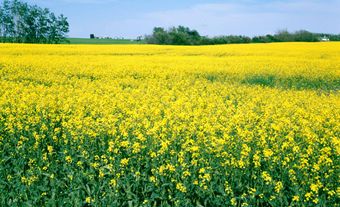
Cereal crops may be divided into spring-sown types, which complete their life cycle in one season (summer annuals), and fall-sown types, which require an overwintering period (winter annuals). Among the fall-sown types, winter rye is the most winter hardy, followed by winter triticale and winter wheat, then winter barley; winter oats are least hardy. No winter forms of grain millets or corn exist. Spring-sown cereals are grown in all provinces except Newfoundland.
Wheat, oats, barley, rye and triticale are considered cool-season crops. Their spring forms are normally seeded between mid-Apr and mid-May, completing their life cycles in 80-100 days under Canadian conditions. The winter forms, seeded in Sept, overwinter as seedling plants and mature the following July. The other cereals are warm-season crops. Corn is seeded during the first 3 weeks of May and requires the full growing season to reach maturity. Grain millets may be seeded in May or June and mature in about 90 days. Rye, corn and sorghum are cross-pollinated species; the other cereal crops are self-pollinated.
Corn
Grain corn is normally planted in rows 70-90 cm apart, with populations of 50 000-60 000 plants per hectare. Silage corn is more productive at slightly higher populations. Grain corn is harvested (with ear-pickers or picker-sheller combines) when the kernel moisture content is 25-30%. The stalks are left in the field and plowed under. Picked whole-ear corn may be stored outside in slatted cribs, which permit air circulation and low-energy, natural drying.
Shelled corn may be dried artificially to 15% moisture content to permit inside storage in open containers, or it may be stored as high-moisture corn without drying, either in airtight containers or in open bins, following treatment with an organic acid to prevent spoilage. Grain yield in corn varies from 5 to 10 tonnes per hectare (t/ha), depending on the length of the growing season, temperature, moisture availability and soil fertility. Whole-plant silage corn yields range from 10 to over 20 t of dry matter per ha.
Small Grain Cereals
Small grain cereals and millets are seeded in rows 15-20 cm apart, at rates of 60-120 kg of seed per hectare. Small grain cereals are normally harvested with combine threshers, with or without prior cutting and swathing. Moisture content at harvest is usually below 15%, allowing storage of the grain without artificial drying. The remaining straw may be left in the field and incorporated with the soil, or removed and used as feed or bedding for livestock. Grain yields from spring-sown small-grain cereals range from less than 2 t/ha, under dry prairie conditions, to over 4 t/ha, under ideal growing conditions in eastern Canada. Where they survive the winter, fall-sown cereals yield 15-25% more than spring-sown types. Straw yields range from 2 t/ha to 4 t/ha.
Usage
The use made of a cereal crop depends on the chemical composition and quality of its seeds.
Small amounts of corn are milled for starch, oil, syrup and other products. Triticale seed is used mainly for feeding livestock but small quantities are milled for flour. Grain millets are used in N America for animal feed and in the bird-seed industry. In some cases, the entire cereal plant (excluding roots) is used; for example, the entire oat plant, harvested well before the grain is ripe, may be used as hay or silage (feed preserved by the acid-forming action of bacteria); whole-plant corn is also preserved as silage.

 Share on Facebook
Share on Facebook Share on X
Share on X Share by Email
Share by Email Share on Google Classroom
Share on Google Classroom



